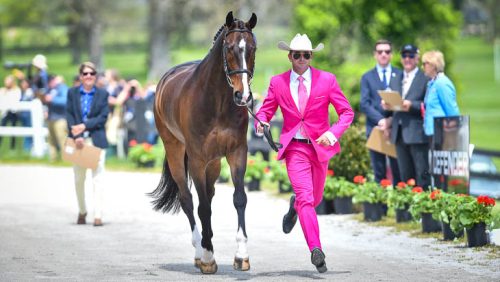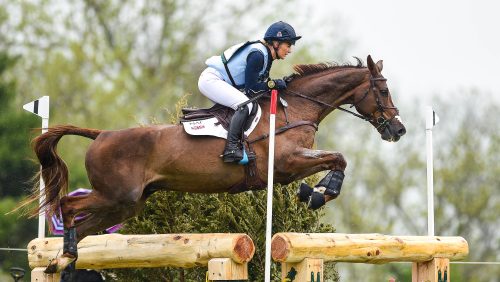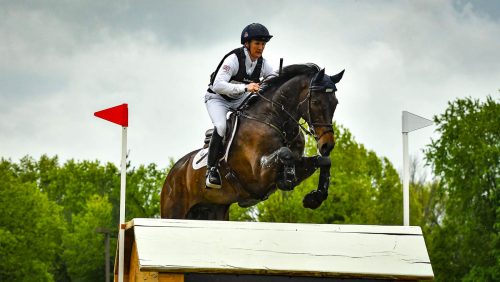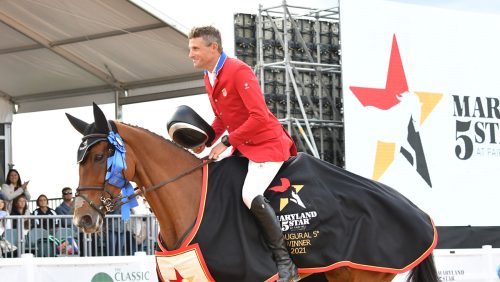Buck Davidson secures top placings with all three of his mounts in the open intermediate divisions.
Buck Davidson was on fire at the Surefire Farm Horse Trials.
He dominated the open intermediate competition on June 27-28 in Purcellville, Va., winning two of the three divisions with Titanium and Fuerst Edition, respectively.
He also rode In The Beat, a Thoroughbred mare owned by his father Bruce Davidson Sr., to third in division 2 behind Titanium and Sarah Cousins on her Yukon Denali, who took second.
Davidson began campaigning Titanium, an 8-year-old Thoroughbred gelding he owns, in 2007 at the novice and training levels. The ex-steeplechaser moved up quickly, his powerful gallop an asset at the upper levels.
“He’s so easy to ride, and he’s just so much fun,” said Davidson. “He goes in a big fat snaffle, doesn’t pull, jumps great and is quiet on the flat. He’s green, but he does everything I ask him to do.”
Davidson might have a future star in the gray gelding. After moving up to advanced in February, Titanium has steadily improved and is becoming a fierce competitor. He placed seventh in his first CCI*** at the Jersey Fresh Three-Day Event (N.J.) in May.
“He’d be a good backup to Reggie and Bobby,” said Buck, referring to his two top mounts, Casssandra Segal’s Ballynoe Castle RM and Carl Segal’s My Boy Bobby. “He’s a really nice horse to ride every day and the sweetest one in the barn.”
Titanium stood eighth in the field of 26 after dressage with a score of 36.2, but with one rail in stadium, he moved up to fourth place.
Cousins with Yukon Denali and Karen O’Connor with Mandiba, who finished seventh, had the only two clean show jumping rounds. Titanium was the only horse in the division to finish cross-country with no time penalties, and his clean jumping efforts put him in first place with a 40.2.
Linda Baumann’s Fuerst Edition, an 8-year-old warmblood gelding, finished with a 41.1 to win division 1. Davidson described the distinctive blue roan as the complete opposite of his stablemate.
“He’s just a bigger horse,” Davidson explained. “He’s not as fast as Titanium, but he’s very comfortable at the intermediate level.”
Despite his heavier type, “Eddie” is a solid competitor. Davidson took over the ride from his father when the horse was competing at the preliminary level in 2007. This was his first win after moving up to intermediate in January of this year. Davidson praised the gelding’s sound mind and his rideability.
“He’s not the best mover out there, but he’s trainable and accurate,” Davidson said. “He doesn’t want to hit the poles, and he’s honest cross-country.”
Davidson and Eddie were 10th after posting a 35.9 in dressage and moved up to sixth after dropping one rail in show jumping. They leaped into first when they added just 1.2 time faults on cross-country to their score.
ADVERTISEMENT
Hannah Sue Burnett and St. Barths were hot on their tail, moving up from 11th after dressage to finish second with 41.7.
Rising Stars
Katlyn McMorris, a 21-year-old native of Barrington, Ill., topped intermediate, division 3, with her New Zealand Thoroughbred gelding, Clifton Peekachu.
An experienced partnership, McMorris and Clifton Peekachu were in second after posting a dressage score of 33.8. They moved up to first despite dropping two rails in show jumping.
Fie Ottosen and Clifton, the leaders after dressage, accrued 16 penalties in show jumping, and there were no clear rounds in the division.
McMorris jumped clean on cross-country, adding 6.4 time penalties to finish on 48.2 penalties. Ottosen finished third behind Meghan O’Donoghue and Pirate, whose jumping efforts propelled them from 14th after dressage into second place.
A student at George Mason University (Va.), McMorris trains with U.S. Equestrian Federation High Performance “B List” rider Allison Springer. Instead of returning home for summer vacation, she remained in Virginia to work for Springer.
Clifton Peekachu stays at Springer’s barn in Marshall, Va., in the spring, summer and fall. In the winter when many top competitors travel to Florida, McMorris stays at school, and her horse returns to her home in Illinois.
“He lives in the backyard in a four-stall barn and enjoys being a horse,” she said with a laugh. “My mom helps leg him up for me before he comes back to Virginia in the spring.”
McMorris bought Clifton Peekachu in early 2004, just after he was imported from New Zealand. He had competed at the CCI* level there, but he was by no means a finished product. Getting to this level has been a challenge for McMorris, but she’s enjoyed big victories along the way.
The pair competed at the North American Junior And Young Rider Championships four times for USEA Area IV, taking team silver in 2005, team and individual gold in 2006 and team silver in 2007. In 2008, they completed the CCI**. This year marks her final year of young riders eligibility, and McMorris hopes to bring home a souvenir to remember her last NAYRC later this summer.
A True Test
Of the 72 intermediate horse-and-rider pairs that entered the show jumping ring on Saturday, four left all of the rails up, and of the 71 that left the cross-country start box, 52 galloped through the finish flags. In spite of the number of rider falls and eliminations, Surefire organizers reported no serious injuries to humans or horses.
The show jumping course was full of related distances, and sometimes one mistake had dire consequences for the rest of the round.
“It was really a course where you had to make decisions in the moment,” said McMorris. “It was so connected from jump to jump that one fence would decide how the next would ride.”
The difficulty of the show jumping course put competitors in an unusual position going into cross-country.
ADVERTISEMENT
“These days, the dressage and show jumping usually decide who will win,” said McMorris. “Because a lot of people had rails in show jumping and the cross-country was tougher, it was the cross-country that helped us win.”
McMorris was up to the challenge presented by the 28-element, 2,740-meter course and had nothing but praise for its design.
“The jumps were beautiful and well-made,” said McMorris. “It was a great intermediate to do before the NAJYRC because the course asked good questions. [Organizer Jan Byyny] did a great job with the event, and I had a lot of fun.”
The utmost attention to detail was paid to the footing and safety of the jumps. After a horse stumbled at the bank, swarms of volunteers converged on the obstacle with rakes to meet a backhoe that delivered new footing. The jump was repaired in time for the next rider on course, who had not been held.
Davidson said that the problems some riders experienced were due to their own lack of preparation to meet the demands of the course.
“When I walked the course, I didn’t think it was very difficult,” Davidson admitted. “Sometimes people walk fences, but they don’t walk courses.”
Davidson explained that the jumps weren’t difficult in themselves, but putting them all together required preparation.
“The first two fences were really show jumping fences because you were turning so much,” he said.
The next two obstacles were simple tables that required a forward gallop. “You needed a good pace to the tables because the next element was the water, off a sharp turn and downhill. The water was OK for people who really galloped to the tables and got the horse in front of the leg,” he explained.
Most problems occurred at the water complex and the bank complex, which came later in the course. The bank consisted of two steps up followed by one stride to a log on top of the hill. The horses then had three or four strides downhill to a skinny brush.
“The bank was a hard question in that the distance between the first step and the second was short, and the distance between the second step and the log on top of the hill was long,” said Davidson. “Once the horses saw the skinny at the bottom of the hill, they were a bit slow to pick up at the log.”
Some horses crawled over the log, and several rider falls occurred at the bank.
“You couldn’t come fast, but you had to have a lot of power,” Davidson explained. “The hardest thing to teach is in front of the leg, rather than speed. I think at this level, people are still trying to figure that out. We all are.”















